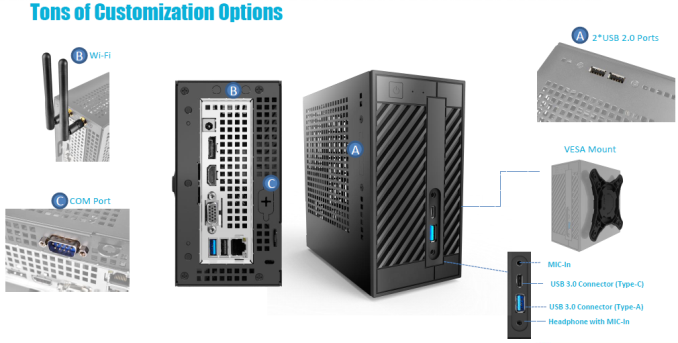ASRock DeskMini 110 mini-STX PC Review
by Ganesh T S on June 8, 2016 8:45 AM ESTConcluding Remarks
The ASRock DeskMini 110 gave us the opportunity to check out what is possible with the mini-STX form factor and a high-TDP Skylake CPU. It is quite clear that Intel's current marketing angle with the mini-STX form factor is affordability. Otherwise, it is difficult to explain why almost all vendors have gone in for a H110 chipset-based design for their mini-STX offerings. That said, ASRock has put in a couple of good differentiating aspects in the DeskMini 110: support for 65W TDP CPUs and a M.2 PCIe slot for SSDs directly connected to the CPU's PCIe lanes. This works around the issue of the H110 chipset having only PCIe 2.0 lanes
The pricing is very competitive - $130 for the all-metal chassis, 120W power adapter and cord, and the H110 motherboard. While the assembly is not as easy as that of a NUC, it is acceptable for the DIY market.
In terms of scope for improvement, a bundled WLAN adapter would be very welcome. Sourcing one that can fit in with the chassis design will be a challenge, as most M.2 PCIe WLAN modules are either meant for NUCs, or for notebooks. The DeskMini's all-metal chassis makes it difficult to get a suitable placement for the flat antennae that come with such WLAN adapters. I think it would be better for ASRock to bundle / pre-install a WLAN module and antennas for a slight increase in the price of the product. The DeskMini could also do with some additional I/O (say, a SD card reader).
It is great to see the mini-STX form factor getting broad vendor support. We would like it more if vendors were able to differentiate their offerings. ASRock has tried out a few things differently in the storage subsystem and chassis design with the DeskMini 110. We look forward to seeing what other differentiation aspects come out in the future iterations in this product line.












85 Comments
View All Comments
8steve8 - Wednesday, June 8, 2016 - link
Am the only one surprised this got beat by the skull canyon with its 45W CPU in many non-GPU related benchmarks? Would a 65W i7 with HT in this change that outcome ( I assume so? )ganeshts - Wednesday, June 8, 2016 - link
Note that the eDRAM might also play a role. (eDRAM is available for both CPU and GPU workloads)8steve8 - Wednesday, June 8, 2016 - link
true... i wish that skull canyon cpu or any skylake with eDRAM was in the anandtech bench databaseValantar - Wednesday, June 8, 2016 - link
Platforms like this are begging for Thunderbolt 3 and similarly sized eGPU chassis.peterfares - Wednesday, June 8, 2016 - link
Why exactly do you want to have two boxes with a wire connecting them and a second power supply? Doesn't it make a little more sense for the case just to be larger and hold a GPU internally? Way cheaper that way too.piasabird - Thursday, June 9, 2016 - link
Seems like 120 watts is awfully low on the power. It is basically just a box with a motherboard in it.peterfares - Thursday, June 9, 2016 - link
65W CPU. I don't think everything else will add up to 55W.cm2187 - Thursday, June 9, 2016 - link
I'm surprised the Skull Canyon toasts this config in pretty much all benchmarks. When comparing the specs side by side, the Skull Canyon CPU is pretty much inferior or equal to the i5 6500 on all metrics other than hyper threading:http://ark.intel.com/compare/93341,88184
Does hyper threading make such a big difference?
nirolf - Thursday, June 9, 2016 - link
There's also that 128 MB of eDRAM that works like a big fat cache for the CPU.TheinsanegamerN - Thursday, June 9, 2016 - link
I agree with the comment section, this box would be much more impressive if it was an inch wider, and had room to hold something like the low profile dual slot 750ti.